
By David Frangeul, Senior Director, Global Air & Ground Practices
Negotiating airfares for your corporate travel program can feel like stepping into the unknown.
Pricing seems to change unpredictably, making it hard to anticipate the availability of future fare options. That’s a huge problem when you’re trying to source the best deals. Luckily, there is a way to access more transparent airfare pricing: Advito’s advanced analytics tool, the Airfare Predictor.

Inside the Airfare Predictor: published and NDC fares
If airfare prices are constantly fluctuating, how can you get an accurate pulse on pricing trends? It starts with the right data. Advito collects publicly available airline prices on a daily basis for over 800 routes, which represents 35 million transactions per year. This data includes information on airport and other taxes as well as fuel surcharges, making the overall cost of any flight completely transparent. Additionally, NDC fare data has recently been added to the data collection process starting with American Airlines worldwide and the NDC feeds from other airlines following throughout the year.
With all this data in one place, the Airfare Predictor uses predictive analysis to shop airfares four months into the future. The predictor’s shopping behavior mimics the business traveler – searching by day of the week and length of stay – making the data relevant to travel managers.
The Airfare Predictor provides a range of filtering tools, so you can change which data is displayed filtering by: airline, type of fare (published or NDC), time period, booking class, carrier, price, route and more. This makes it easy for you to focus on the most important data for your program. For example, you can use the Airfare Predictor to assess the added value of including American Airlines NDC fares on US domestic routes in your program. By comparing the lowest available American Airlines NDC and published fares to Delta and United GDS-Edifact fares on the exact same round-trip flights (Basic fares excluded) we can tell you if plugging the American Airlines NDC channel will add value to your program.

The tool also provides information on booking class availability for each airline, so you know exactly what will be available and when. And, most importantly, the tool creates constantly updated pricing curves, so you can see when prices are likely to rise or fall. This helps you identify the ideal timeframes for booking travel.
Three benefits for travel managers
Using the Airfare Predictor brings three major benefits to travel managers: transparency on pricing, reduced spend and better information to influence traveler behavior.
1. Improved transparency
Negotiating deals on rates that are actually available to your travelers is key to a successful strategy. With improved transparency available via the Airfare Predictor, travel managers no longer have to negotiate blindly. Using the tool, you can easily see when a particular booking class has low availability, so you don’t waste your time trying to get a deal.
Plus, with access to transparent pricing, you can make more data-driven decisions. For example, if you know the fuel surcharge is higher on one flight than another, even though the net price is lower, you can factor this in when making a decision about the best carrier to use. The Airfare Predictor puts you in the driver’s seat for air travel sourcing.
2. Reduced spend
For most corporate travel programs, air travel is the biggest expense. The Airfare Predictor can help reduce that spend and drive savings. The transparency on NDC fares is critical to assessing new savings opportunities. The addition of American Airlines NDC fares in the Airfare Predictor (with additional airlines to come in 2024) will help you to decide if an NDC feed is needed for your program now. By consistently comparing fare options in the Airfare Predictor, you’ll be able to identify the most cost-effective options and communicate those options to your travelers, leading to reduced spend over the course of the year. These insights will also give you more leverage as you approach supplier negotiations.
3. Opportunities to influence traveler behavior
To drive meaningful change within your air program there are several traveler engagement strategies that you can use to keep travelers informed based on the insights you gather from the Airfare Predictor. For example, if you identify the most and least expensive days to fly on a particular route, you can steer travelers toward the most affordable option. From integrating targeted messaging directly into your online booking tool to creating multichannel communications campaigns, you can successfully influence their booking decisions to align with your goals.
The bottom line is: with more transparency on airline pricing based on constantly updated data, you’ll be able to run a more cost-effective air travel program. Contact us to learn more about how Advito’s Airfare Predictor can help you drive savings.
